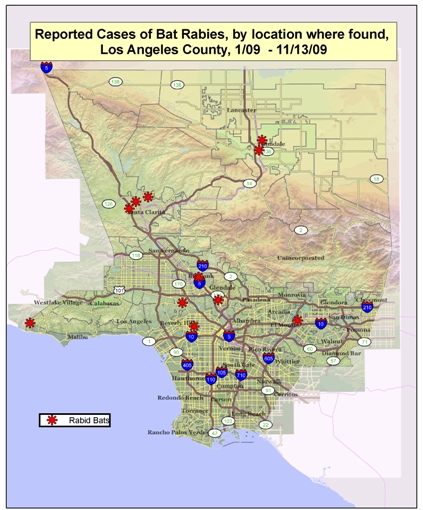A total of twelve rabid bats were detected in Los
Angeles County in 2009.

This number is about what
would be expected during a normal year.
Circumstances of rabid bats found in 2009
1. Found dead inside of a suitcase after a person
returned home from a camp.
2. Found weak but alive on the ground in the parking lot
of a grocery store.
3. Found in the walkway of an apartment complex,
clinging to the wall two inches above the ground.
4. Seen in daylight on the side of a condo for several
hours. A cat was reaching for the bat but did not touch
it.
5. Seen in daylight on the floor of a porch, later seen
on the ground in a driveway, hissing at a person.
6. Found in airplane hangar.
7. Found on ground in a backyard unable to fly.
8. Found hanging in daylight just outside front
door. Bat tried to fly into house when door opened.
9. Flew into house at dusk, flew around several well-lit
rooms, was caught with clean jar (air holes put in lid
for ventilation).
10. Two bats flew into apartment. First bat was found
and removed right away. Second bat found three days
later on floor, weak. The second bat tested
positive for rabies. Two people required rabies
post-exposure treatment because they had been sleeping
in a room with a bat for three days and an undetected
bit may have occurred.
11. Bat found outside a veterinary clinic. Child picked
up with bare hands and showed to siblings. The one child
needed treatment for rabies exposure.
12. A bat found in airplane hangar (same location as bat
#6).
Bats and Rabies.
Bats are the animal that most commonly
carry rabies in our county. Most bats do not have
rabies, and try to avoid contact with people and
pets. Bats are good for the environment because they eat
insects and pollinate plants. Bats are also protected by
law.
Bats seen flying in daylight, or found
on the ground, are more likely to have rabies. Never
touch a bat or other wild animal. If you pick up a bat
with your bare hands, you may be bitten and exposed to rabies.
Bats that bite a person or pet should be tested
for rabies. The bite mark from a bat can be very small
and hard to see. Bats that are found indoors near a
sleeping person, young child, adult that cannot speak,
or pet should also be tested for rabies. In
these cases, try to gently trap the bat without touching
it (such as covering it with a bucket), and call your
local animal control agency. To see a list of local
animal control agencies,
click here. You
should also talk to your doctor and/or veterinarian in
these situations.
PRINTABLE VERSION of map

Links about rabies
Centers for Disease
Control - Rabies pages
Los Angeles County Department of Public Health
Webpages
Local Rabies
Overview
Rabies
Control Manual
Human rabies
To see a map of all rabid bats found in Los Angeles
County from 2000 through 2010 click
here.
Last updated February 16, 2010